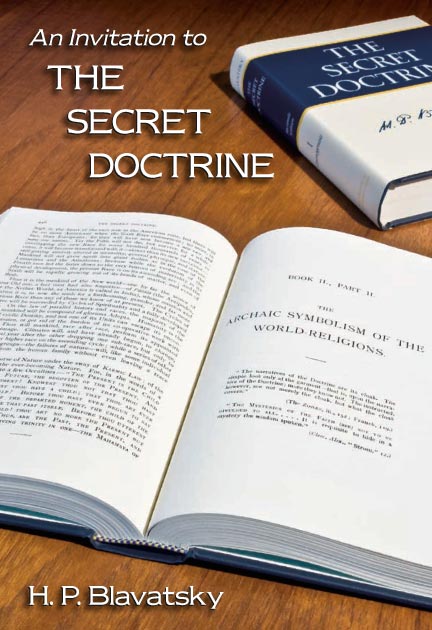
Copyright © 1988 by Theosophical University Press (print version also available). Electronic version ISBN 978-1-55700-031-6. All rights reserved. This edition may be downloaded for off-line viewing without charge. No part of this publication may be reproduced or transmitted for commercial or other use in any form or by any means, electronic, mechanical, photocopying, recording, or otherwise, without the prior permission of Theosophical University Press. For ease of searching, no diacritical marks appear in this electronic version of the text.
Text from The Secret Doctrine is reproduced from the original 1888 two-volume edition.
NOTE: The illustrations are separate image files in this same directory; they appear automatically during online viewing, but must be downloaded separately into the same directory in order to appear during offline viewing.
The "Secret Doctrine" and Its Study by Robert Bowen (16K)
From THE SECRET DOCTRINE — Volume I (87K)
Title Page and Dedication
Preface
Three Fundamental Propositions from the Proem
Stanzas of Dzyan — Cosmogenesis
Summing Up
From THE SECRET DOCTRINE — Volume II (98K)
Title Page
Preliminary Notes
Stanzas of Dzyan — Anthropogenesis
Conclusion
"And now to conclude."
Illustrations:
Original manuscript pages of The Secret Doctrine
Galley proof of the last page of The Secret Doctrine
The Writing of The Secret Doctrine by Kirby Van Mater (34K)
Illustrations:
HPB at "Maycot," Upper Norwood, London, 1887,
Letters from M and KH on the SD as a "triple production"

Theosophical University Press, publishing and distributing quality theosophical literature since 1886: PO Box C, Pasadena, CA 91109-7107 USA; Email: [email protected]; Tel: (626) 798-3378; Fax: (626) 798-4749. Free printed catalog available on request. Visit the on-line TUP Catalog.
Shortly after The Secret Doctrine was published in November 1888, H. P. Blavatsky met with students in London to answer questions on the Stanzas of Dzyan, those esoteric verses on which the SD is an inspired commentary. While shorthand notes of meetings held in early 1889 had been published in her lifetime as Transactions of the Blavatsky Lodge, apparently later gatherings (1890 until her death in 1891) were not recorded. Providentially, Robert Bowen wrote down his impressions and as much as he could recall of HPB's remarks. His notes lay buried for forty years until his son, Captain P. G. B. Bowen of Dublin, Ireland, on going through his father's papers, discovered them and published extracts in Theosophy in Ireland under the heading "The 'Secret Doctrine' and its Study." (1)
An Invitation to "The Secret Doctrine" is a succinct and appealing statement of the SD's principal truths in H. P. Blavatsky's own words. Rather than reading the book page by page she felt it important for the student first to grasp the Three Fundamental Principles on which the whole of the philosophy rests; then to study her Summing Up in volume I, and in volume II her Preliminary Notes which outline three further propositions, and her Conclusion. These selections are here reproduced, and we have added HPB's Preface and the Stanzas of Dzyan, as they set the tone for the entire work. Also included are the last few pages of the SD, Commander Bowen's report and, for historical purposes, "The Writing of The Secret Doctrine" by Kirby Van Mater, revised from his essay in Sunrise (November 1975).
Each of us approaches the SD according to our temperament and background: a good many like to roam freely and pursue their own intuitive leads; others like to read it straight through before tracing down specific themes; still others feel overwhelmed by the vast scope of the work and want direction in getting started. Guidelines, however, are two-edged: they can help or they can hinder, encourage or discourage a student. They must be well thought out yet open-ended, for if they are too logically organized they stifle intuition, the faculty we most need for comprehending grand abstract truths.
"Every form, no matter how crude," HPB told her London group, "contains the image of its 'creator' concealed within it. So likewise does an author's work, no matter how obscure, contain the concealed image of the author's knowledge." Bowen was profoundly moved: to think that the SD contains knowledge greater even than that of HPB — as it must if "much of it comes from men whose knowledge is immensely wider than hers"; and that anyone, even he, could find in HPB's words "knowledge of which she herself is unconscious." The thought is electric. Now, after a hundred years of the SD's being in circulation, we have a growing sense of its magnitude. Instead of becoming fainter with time, its dynamism is augmented, giving dimension to the mahatmic statement that The Secret Doctrine was the "triple production" of her teachers and herself.
To those who are drawn to theosophy and would like to explore the SD, An Invitation should prove welcome. Longtime students may also find it useful as a refresher course on the genesis and evolutionary destiny of our solar universe and its family of planets and of human and other life-waves of monads that compose and inhabit our earth. To some it will become a faithful companion, by the bedside, on trips, and at those moments when the power and beauty of the Stanzas yield their own blessing.
— Grace F. Knoche
Theosophical University Press
Pasadena, California
August 24, 1988
FOOTNOTE:
1. A reprint appeared in The Theosophical Forum (August 15, 1932) and in Sunrise (August/September 1985). It forms the basis of Ianthe Hoskins' booklet, Foundations of Esoteric Philosophy from the writings of H. P. Blavatsky (1980). (return to text)